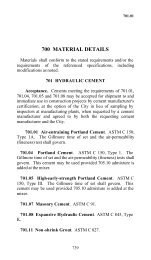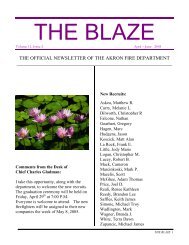Akron Water Pollution Control Station No Feasible Alternative
Akron Water Pollution Control Station No Feasible Alternative
Akron Water Pollution Control Station No Feasible Alternative
You also want an ePaper? Increase the reach of your titles
YUMPU automatically turns print PDFs into web optimized ePapers that Google loves.
Table 3-1<br />
1994 Modified NPDES Permit Effluent Discharge Limits<br />
Discharge Limitation<br />
Parameter 7-day 30-day Units<br />
Monitoring <strong>Station</strong> 602 – Final Settling Tank Effluent<br />
Total Suspended Solids (TSS) 23 15 mg/l<br />
Nitrogen (NH3-N) mg/l<br />
June-September 2.3 1.5 mg/l<br />
March-May, October-<strong>No</strong>vember 7.1 4.8 mg/l<br />
December-February 11.3 7.5 mg/l<br />
Phosphorous (P) 1.5 1.0 mg/l<br />
CBOD5 15 10 mg/l<br />
Monitoring <strong>Station</strong> 603 – Primary Effluent/Secondary Bypass 1<br />
Total Suspended Solids (TSS) --- 157 mg/l<br />
CBOD5 --- 91 mg/l<br />
1 Discharge to <strong>Station</strong> 603 only when plant peak influent flows exceed<br />
110 MGD and the flow to equalization pumping capacity is being<br />
maximized due to storm-related events and activities.<br />
Table 3-2 summarizes WPCS performance for 2001 through 2005.<br />
The following sections provide detailed technical data on the overall process design, and a<br />
specific review of the secondary treatment system.<br />
3.2. Hydraulic and Process Capabilities<br />
Table 3-3 is a design data summary of the existing facilities including their design loading rates.<br />
Process capacities are primarily based on the Recommended Standards for Sewage Treatment<br />
Works 2 (Ten States Standards) although, in some cases, a process capacity based on<br />
ASCE/WEF Manual of Practice 8 5 (MOP 8) is indicated. Table 3-3 is reprinted and updated from<br />
the City of <strong>Akron</strong> Facilities Plan 98 6 . A detailed narrative describing each process facility<br />
accompanies the Design Data Summary table in Section 8.5.3 of that document and may be<br />
referenced, as needed.<br />
The focus of this <strong>No</strong> <strong>Feasible</strong> <strong>Alternative</strong> Report is the capabilities of the WPCS secondary<br />
treatment system in conjunction with selective utilization of the secondary bypass conduit. The<br />
capacities of the secondary treatment system are reviewed in more detail in the following<br />
section.<br />
Page 3-2







